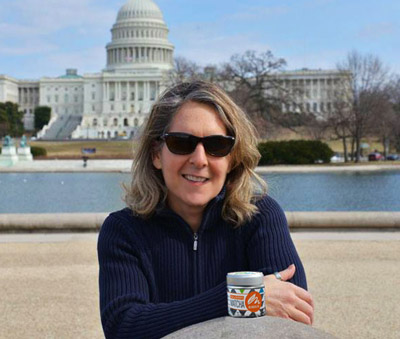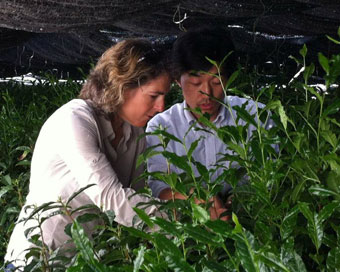
Calli O’Brien, founder and CEO of My Matcha Life | Photo courtesy of Calli O’Brien
Having personally hand-picked Japanese matcha tea leaves, Calli O’Brien learned about matcha literally from the ground up. She has worked with the best matcha Tea Masters on the planet, toured the Japanese mills where the world’s finest matcha powder is still stone-ground to perfection, and managed the packaging, labeling, transportation, product development, marketing and retail distribution of matcha tea products on three continents. After almost a decade of experience in the matcha industry, Calli decided to start her own matcha business, My Matcha Life.
What do you do at My Matcha Life?
Everything! Technically speaking I am the visionary and CEO, but as we are a new company at this time I look after pretty much all aspects; sales, purchasing, packaging, labeling, marketing, shipping when necessary! Social media, biz development, business strategy, etc., and some bookkeeping.
Have you always had an interest in tea?
I have a laugh when asked this because I am not a tea lover or drinker except for matcha. Occasionally I like a Rooibos tea or ginger tea made from fresh ginger.
You previously worked at DoMatcha. What was that experience like?
I came to love matcha and its history and production through my 9 years promoting DoMatcha. I was fortunate to be able to meet and work with some of the top matcha tea masters and producers in the world. Which for matcha really means Japan. I traveled throughout the US and Canada educating people about the knowledge I had learned. And learning from the feedback from all those people. I loved it.
What was it like working with the world’s top matcha tea masters?
Eye-opening, frustrating, and inspiring!!

Calli O’Brien gets up close and personal with tea leaves | Photo courtesy of Calli O’Brien
When did you decide to leave and start your own matcha business?
In the summer of 2014 the business structure at DoMatcha was changing while at the same time my aging mother, who lived across the way from me, was really in her last few months of life, so I decided to focus on my time with my mom and wasn’t sure what I was going to do exactly. Maybe a natural health broker or start my own matcha company, I wasn’t sure. I finally launched My Matcha Life in March of 2015.
What makes My Matcha Life matcha special?
Because of my experience and contacts in the matcha industry over the past 10 years and my understanding of what matcha drinkers here wanted, I was able to select the best matchas for the grade, for the nutritional profile, and for the price. We offer top quality matcha at three different grade levels, one for the Purists, one for the Health Enthusiasts, and one for the Fun Foodie in all of us. Respectively: our Tea Lover’s Organic Ceremonial Matcha, our Barista’s Matcha, and then our Foodie’s Culinary Matcha.
You traveled extensively through Japan to find the best matcha. What was that like? Do you have any tips for readers wanting to visit Japan and go on their own matcha tasting trip?
Japan’s matcha producers make up a very intimate group where everyone knows everyone. Most have been producers or growers, or both, for generations. It has been interesting to see the respect they each have for one another, it’s not how North Americans do business! Japan is a fabulous country, but it’s full of nuances and layers… so keep your wits about you when you go. Japanese Tea Ceremonies aren’t everyone’s “cup of tea” either, so I personally would go see the artisans involved in matcha production, and the farms themselves. Go have a matcha at a farmers farmhouse, it’s a truly exceptional experience.
What should readers know about drinking matcha?
It’s a personal thing. There really isn’t a right or a wrong way to drink it or use it. However……the best experience of matcha happens when you drink it with simply hot, not boiling, water. This allows the l-theanine full access and you get that beautiful wave of calmness, assuredness and mental clarity coming over you. There’s no other experience like it.
What should readers know about cooking with matcha?
Make it fun! You can put it in anything. Sauces, soups, desserts, cocktails, breakfast cereals, fish, mixed with herbs, etc. Cooking will affect the antioxidants in the matcha so if you are going to cook with it get a good quality culinary grade with a price per gram about 0.22-0.25 cents. Poor quality culinary grades of matcha can be brownish in color, and give your recipe an “off” taste and color.
Do you have any recommendations for readers wanting to learn more about matcha?
We have a fairly comprehensive site on matcha, its health benefits, FAQ’s, recipes, history, etc., or they can read The Matcha Report 2015 that I co-wrote… I’d suggest Matcha 101 and under our blog pages there are some fun “how to” videos as well.
Read our review of My Matcha Life’s Tea Lover’s Matcha (Organic, Ceremonial Grade) »